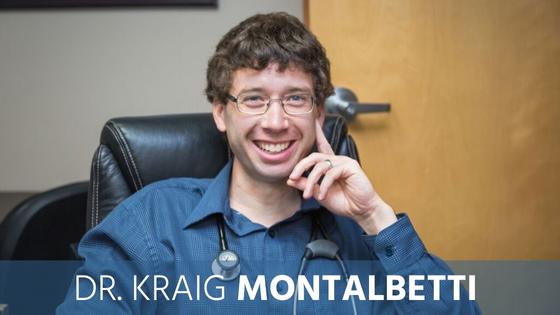Halfway into a discussion about BC’s doctor shortage, payment models, work balance, and running a family practice, Dr. Kraig Montalbetti pauses, reflecting on his relationships with his patients.
“In one week, I got four salmon fillets, a chicken, several bags of garden produce, homemade baking, a coffee gift card, and a homemade thank-you card from a 99-year-old patient and her daughter.
“We are appreciated,” Dr. Montalbetti says. “And I’m really worried about the future of family practice. I’m concerned that new medical grads are being told that they don’t want to practice the way I practice, and because of this they will lose out on the most rewarding parts of family practice.”
Dr. Montalbetti finished his residency in 2008, locumed for a while, then took over the practice of the Kamloops doctor who delivered him at birth, Dr. Ron Oyler. That was 11 years ago. Today, Dr. Montalbetti is one of 11 family doctors at Aberdeen Medical Clinic. He pays rent to the five doctors in the group who own the building, and runs his own family practice and patient list.
Dr. Montalbetti is a fiercely outspoken defender of the traditional family practice.
“It’s not a universal rule that doctors don’t want to run their own practices. I get the support of our group of 11 doctors, and still maintain my autonomy. That autonomy helps provide me a work-life balance,” says Dr. Montalbetti, who referees for high school and university basketball programs, and is president of the Kamloops Basketball Officials Association.
“I think fee-for-service is very fair. There’s no one perfect billing system, but you don’t need an MBA to run a doctor’s office, it’s not that hard. If you graduated med school, you can calculate stat pay.”
Dr. Montalbetti says he would like to see BC’s business cost premium improve for family doctors, currently at three per cent, which goes towards his practice’s 30-per-cent overhead.
“When I say I actually like running my own practice people are surprised. ‘Why give up 30 per cent of your income to overhead?’ I hear that all the time,” he says. “It’s because there’s more to it than that. I can take much better care of someone I know, practicing medicine is easier that way.”
He worries that the social contract is eroding between doctors and the public: As physicians seek less hours and less responsibility for business and patient decisions, the public offers less respect, trust, and remuneration in return.
Dr. Montalbetti is responsible for fewer patients than most physicians who work his hours but he is quick to point out that the number of people is not the important part of the story.
“The number of patients you have is not an accurate reflection of the care that you give. I keep a really close eye on my patients. It’s about quality over quantity,” he says. “You get to know your patients over time. When I go visit patients in the hospital it’s my name on their wristband, it’s my name on the chart on the wall. I know they are scared or worried about being there, and seeing a face that they know and trust is important.”

